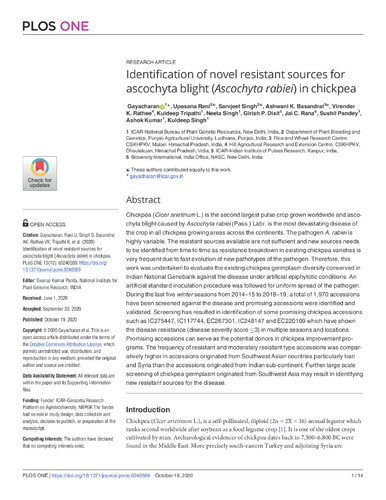Identification of novel resistant sources for ascochyta blight (Ascochyta rabiei) in chickpea
Chickpea (Cicer arietinum L.) is the second largest pulse crop grown worldwide and ascochyta blight caused by Ascochyta rabiei (Pass.) Labr. is the most devastating disease of the crop in all chickpea growing areas across the continents. The pathogen A. rabiei is highly variable. The resistant sources available are not sufficient and new sources needs to be identified from time to time as resistance breakdown in existing chickpea varieties is very frequent due to fast evolution of new pathotypes of the pathogen. Therefore, this work was undertaken to evaluate the existing chickpea germplasm diversity conserved in Indian National Genebank against the disease under artificial epiphytotic conditions. An artificial standard inoculation procedure was followed for uniform spread of the pathogen. During the last five winter seasons from 2014–15 to 2018–19, a total of 1,970 accessions
have been screened against the disease and promising accessions were identified and validated. Screening has resulted in identification of some promising chickpea accessions such as IC275447, IC117744, EC267301, IC248147 and EC220109 which have shown the disease resistance (disease severity score 3) in multiple seasons and locations. Promising accessions can serve as the potential donors in chickpea improvement programs. The frequency of resistant and moderately resistant type accessions was comparatively higher in accessions originated from Southwest Asian countries particularly Iran and Syria than the accessions originated from Indian sub-continent. Further large scale screening of chickpea germplasm originated from Southwest Asia may result in identifying new resistant sources for the disease.

